Even the best golfers in the world cannot find the green every time with their approach shots. They often miss the target numerous times in a round. A nicely played chip gives you an outside chance of a “chip-in” birdie, which will send you off to the next tee with a spring in your step.
Even if you do not hole the shot, the ball should finish close to the hole. This takes the pressure off your putting—a significant factor when you are under pressure to produce a good score.
A proficient chipper must control the four key ingredients that combine to determine where the ball comes to rest on the green: height, carry, spin, and roll.
In order to chip a golf ball consistently, you need to have a solid understanding of the basic fundamentals. In this blog post, we will discuss some of the key points that you need to focus on in order to improve your chipping game. We will also provide some helpful tips and drills that you can use to practice and improve your skills. Let’s get started!
Table of Contents
How To Chip A Golf Ball Consistently?
The sequence below shows you how to consistently make the perfect chip shot—as demonstrated by Barry Lane.
Step#1
Always remember the adage: ball back, hands and weight forward. This means that you should keep the ball back in your stance. Make sure your hands are ahead of the ball, with the shaft angled toward the target. Let your weight favor your front foot, the left foot. This encourages a descending angle of attack into impact.
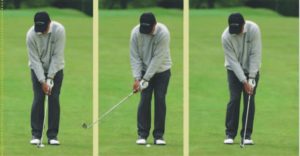
Step#2
The backswing is a simple movement whereby the triangular relationship established at address between your arms and your shoulders is maintained as the club moves away from the ball. The weight distribution remains the same, still favoring the left side.
The trouble for the majority of golfers starts when the backswing is either too short or too long for the shot in question.
Step#3
As your arms and body begin the transition from backward to forward motion, a softness in your hands and wrists produces a slight lag in your wrists and a sense that your hands are leading the clubhead down toward the ball.
It is a subtle move, but a decisive one, especially on a shot as short as this. It is an essential ingredient of a crisply struck chip shot.
Step#4
Through the hitting zone, the contact should be ball-then-turf, the hallmark of all good players, and a skill that allows good control of spin and trajectory. Through impact, make sure your hands stay ahead of the clubhead as your body turns through.
This coordination is extremely important— if your body stops moving, the club tends to overtake your hands and it is easy to strike the ball poorly as a result.
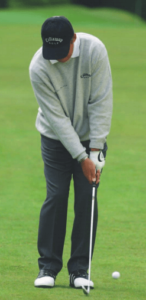
Step#5
Keep your eyes down until the ball is well on its way. Note the economy of movement; almost perfect symmetry on either side of the ball. It is such a neat action with no wasted motion. With shots such as this there should always be a sense of natural acceleration through the ball.
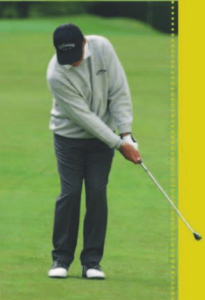
Organize your set-up to make chips seem easy
If you have a fundamental problem striking your chips cleanly, then the prospect of playing any shot from around the green can be intimidating. In this case, it is likely that your set-up is to blame.
Even those who consider themselves reasonable chippers would be wise to take this opportunity to revisit the basics. This simple exercise—which can be done at home, in the backyard, or at the course—will ensure that you have the correct address position.

Step#1
Stand with your feet, hips, and shoulders slightly open to the target (if you imagine the target as 12 o’clock, align yourself to 11 o’clock). Your feet should be only 6–8in (15–20cm) apart.
Step#2
Place the ball back in your stance: opposite the right instep. Settle your weight to favor the leading foot. A ratio of 40 percent of your weight on your right foot and 60 percent on your left is ideal for a chip shot.
Step#3
Place the clubhead behind the ball and move your hands forward so that your left arm and the shaft of the club form a straight line down to the ball. The clubface should be positioned so that it is aiming straight at the target.
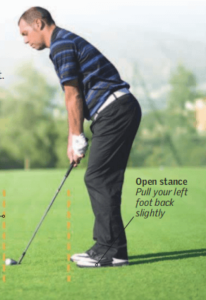
Go back low, then release and hold
The technique described here applies to a medium-length chip of about 13yd (12m). However, for shots of various lengths, you can still apply the same techniques described in this drill—the only thing that changes is the length of your backswing (shorter to send the ball a lesser distance; longer to send it a greater distance).
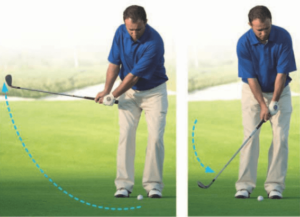
Step#1
Assume the address position. In your sweep, keep the clubhead low to the ground for the fifirst 12in (30cm). Stop your backswing when your hands reach 8 o’clock.
Step#2
Moving to the downswing, you should feel a softness in your hands (“lag”). This prevents the clubhead from overtaking your hands before impact.
Step#3
When you are familiar with these movements, you can then move on to hitting a ball.
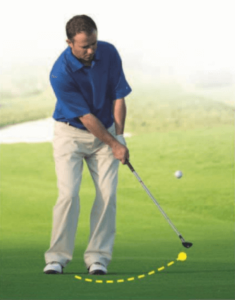
Coaching tip: Your body must move, even in a swing that is as short as this. As your arms swing back and forth, your body rotates backward and through, everything works in harmony. If your body is motionless in your downswing, the clubhead will pass your hands before impact, and the club will meet the ball on an upward path, which is not desirable.
Brush the grass to find the perfect ball position
It is amazing how many golfers put the ball too far forward in their stance for chip shots.
Although having the ball forward in your stance may feel comfortable, it can also cause problems with ball striking: either you hit the ball on the up or hit the turf before the ball—both scenarios are disastrous.
However, this drill will confirm the ideal spot to place the ball in your stance.
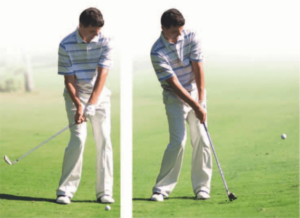
Stand on an area of closely mown grass. For the moment, do not position a ball. Make some swings. Note where the clubhead first comes into contact with the ground. This is where you need to position the ball in your stance to ensure clean contact.
Step#2
Place a ball on the spot described in step 1. Swing as before, but let the ball get in the way of the swinging club. You should strike the ball first and then the turf, leaving a small divot mark if the ground is soft or the faintest bruising of the ground if conditions are hard underfoot.
“POSITIONING THE BALL FORWARD IN YOUR STANCE MAY CAUSE A POOR STROKE”
Play off a hard surface for a clean strike
This exercise highlights the benefits of practicing from a tough spot to improve your overall technique. Although it is challenging at first, the drill ultimately improves your chipping action and makes playing normal chip shots seem simple. This will boost your level of confifidence around the greens, which is a valuable asset to have.

Step#1
Place a ball on a hard, bare surface, such as tarmac, or paving stones—anything that has no give in it. Use an old pitching wedge that you do not mind scratching. Put the ball back in your stance and push your hands forward, and body-weight to your left side.
Step#2
Hit some short chip shots of no more than 20yd (18m). For now, a target is irrelevant: the goal of this exercise is to strike the ball cleanly from an unforgiving surface.
Keep your hands in front of the clubhead all the way into the hitting area. This will help prevent your clubhead from hitting the bare surface before it reaches the ball.
After a few tries, you should achieve some success. Next time you play a chip shot from grass, it will look far more inviting.
Create a downward strike for crisp chips
One of the worst crimes you can commit while chipping is to try to help the ball into the air with a scooping motion through impact. For short shots you need to hit down on the ball in order to make it go up. This drill shows the benefits of this technique.
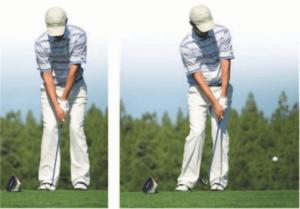
Step#1
Place a ball on a good lie, and position a headcover about 8in (20cm) behind it. At address, your hands must be ahead of the clubhead and the ball opposite your right instep.
Step#2
Hit a chip shot of about 20yd (18m). To avoid hitting the headcover you have to strike down on the ball.
This produces the ball-then-turf contact, a good ball-flight, and a bit of backspin on landing. If you try to scoop the ball into air, the clubhead will collide with the headcover during your downswing.
A bare left hand can offer extra touch and feel
Most golfers putt with their bare hands. This gives a more delicate feel for the putter throughout the stroke. Many of the world’s top golfers find this also applies to chip shots (the enhanced grip that a glove offers for long shots is not required for most short shots).
You too might consider the benefits of chipping without a glove. However, you must find an “outer limit” (determined according to personal preference), after which you wear a glove. Stick to this limit so that you are never undecided about whether to play a chip with or without a glove. Chipping with bare hands might be a welcome change.
Many golfers take their glove off to chip, since this enhances control of the club.
Clip a tee to promote a free swing
In a full swing, the clubhead travels so fast that there is no danger of the club stopping at impact.
But with chipping, where the swing is short and delicacy is often required, it is easy to stub the clubhead into the ground behind the ball.
The turf, instead of the ball, then soaks up the energy. This drill shows you how to be more positive in your approach to chipping, encouraging you to make a freer swing of the clubhead.
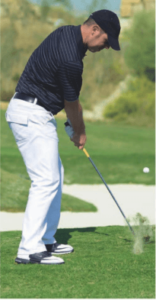
Step#1
Tee up a ball about 3/8in (1cm) off the ground. Address it as you would in case of a normal chip, using your pitching wedge.
Make a smooth, free swing of the club: focus on flattening the tee into the ground at impact (below). This helps you to accelerate your clubhead through the hitting area. Try to ignore the ball. When you succeed in flattening the tee, you will see yourself producing nicely flighted chips. Repeat the step a few times.
Flattened tee

Try the “Bellied Wedge” shot from the collar of rough
One of the most perplexing dilemmas for golfers is when the ball rests against the collar of rough bordering the apron of the green. In this situation, neither a putter nor a wedge seems to be the appropriate club. The solution is a shot called the “Bellied Wedge” shot, which involves striking the equator of the ball with the leading edge of the clubhead.
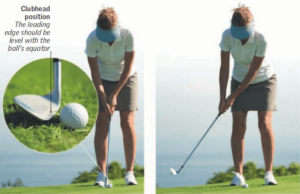
Step#1
Using your pitching wedge, adopt your putting grip and posture. Choke down on the club, as this enhances your control of the stroke.
Step#2
Hover the clubhead so that the leading edge is level with the ball’s equator This way the club will not become snagged in the rough.
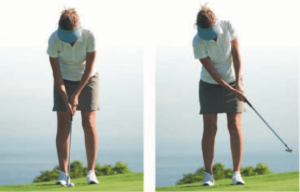
Step#3
Keep your head and body still and make a firm-wristed stroke back and forth. Ensure your wrists barely hinge—this is the “dead-hands” technique.
Step#4
Strike the middle of the ball with the leading edge of the clubhead. The ball might slightly hop, but it should roll like a putt thereafter.
Try the “toe-poke” with a putter
You might have seen a few tour professionals striking the ball with the toe-end of the putter when playing a shot from the collar of rough around the green.
This technique might seem unorthodox, but there is considerable logic to the shot, which is known as a “toe-poke.” Although it is close to the flag, the collar of rough creates a very awkward lie. The tendency is to play too delicate a shot from this position, leaving the ball well short. The toe-poke is a useful remedy for this dangerous inclination.
Step#1
Place a ball against the collar of rough beside the apron of a green. Now, instead of reaching for your wedge, take your putter out of your golf bag.
Step#2
Hold the putter so that the toe-end of the club is hovering behind the ball’s equator. The end of the club should also be pointing toward the hole.
Step#3
Make a short, sharp, stabbing stroke and aim to strike the center of the ball. You will find that there is no interference from the grass behind the ball—the primary reason for playing the shot in this way. The ball will pop into the air before the topspin takes effect, allowing it to roll on to the putting surface.
Play a mini-hook shot to give your chips more run
This advanced chip shot is best described as a miniature hook. Before you attempt it, keep in mind that a hook produces right-to-left spin, which makes the ball run farther than normal.
This makes it a useful shot to have in your repertoire when you have a lot of green between yourself and the pin. The drill given here helps you perfect the shot.
Select a short iron, such as an 8-iron. Position the ball well back in your stance, opposite your right toe, and place your hands well in front of the clubhead (even more so than for a normal chip shot). Also, feel that you align your body a little right of the target, with the clubface aiming straight at the flag.
Practice with a lofted wood
Chipping with a lofted wood has become popular since the likes of Tiger Woods and Greg Norman have played this shot in major competitions. This practice drill demonstrates how you can use the lofted wood effectively for shots close to the green.

Step#1
Take a 3- or 4-wood and choke down on the grip so that your lower hand almost touches the metal of the shaft.
Step#2
Adopt your normal chipping set-up. Stand a little taller and farther from the ball than when using a wedge (or your hands and arms become tucked into midriff, leaving no room for movement).
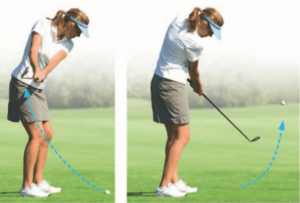
Step#3
Take the club back on a path that is distinctly more on the inside than for a regular chip shot.
Step#4
Swing the club into impact on the same path, so that the clubhead travels right of the target. This in-to-out path imparts the right-to left spin, making the ball fly low and roll more.
“THE LOFTED WOOD CAN BE EFFECTIVELY USED FOR SHOTS CLOSE TO THE GREEN”
Step#5
Make a putting stroke, swinging the clubhead low to the ground with little wrist hinge. This makes the clubhead brush the ground and the ball roll quickly over the green.
Use upturned umbrellas
To be a good chipper, you have to control the height, carry, spin, and roll of the ball. The following exercise is based on a popular practice drill, but with an added twist to enhance your judgment of two of the four key elements: height and carry
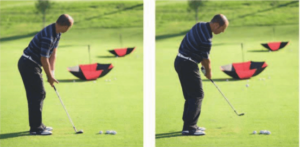
Step#1
Stick two open umbrellas into the ground, approximately 5 1⁄2 yd (5m) apart. Place a batch of balls about 5 1⁄2 yd (5m) from one of the umbrellas.
Step#2
Using your pitching wedge, alternate hitting one ball to the closer umbrella and the next ball to the farther one. Try to land every ball in an umbrella.
Monitor your swing path
In a chip shot, the clubhead travels through impact at a slower speed than with a full iron shot, which makes it hard to monitor the path of the clubhead. The following drill can show you how to do this.
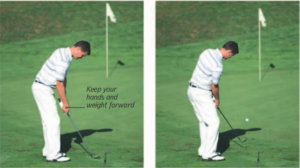
Step#1
Place a club about one clubface- length on the other side of the ball, parallel to the ball-to-target line. Address the ball with a pitching wedge. Keep the ball back in your stance.
Step#2
Play a chip shot. Your club should travel on an inside arc during the backswing, parallel to the obstruction through the hitting zone, before arcing to the inside in the follow-through.
Throw some balls
This drill is designed to train you to visualize shots before playing them. It uses the simple action of throwing a ball to improve your understanding of height and roll. A better grasp of these key concepts will be of great benefit to your chipping.
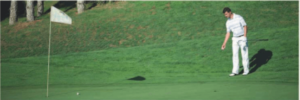
Step#1
Stand about 30 yd (27m) from a flflag. Have on hand at least 10 balls and a selection of clubs, from a 7-iron to a sand wedge. Lob a ball underarm and try to finish as close as possible to the flag. Use a low trajectory, which will produce plenty of roll. After a couple of tries you should find your range quite accurately.

Step#2
Now throw a ball underarm high into the air so that it bounces near the flag and does not roll far. You will find it much more difficult to get the balls to finish close to the flag. Not only that, but also the general dispersion of the “high” balls will probably be more erratic. Keep throwing balls, always varying the height and roll.
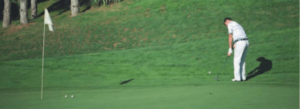
Step#3
Now hit some chip shots. Think of the trajectory and roll you achieved with your throws, and try to re-create these by selecting clubs with different lofts. Again, you will find that the low shots nearly always finish closer than those hit high.
Rehearse, look, and hit
Many golfers chip poorly because they fail to make use of their natural “touch” and hand-eye coordination. By practicing chipping as outlined in the following drill, you will use these attributes to improve your performance around the greens.
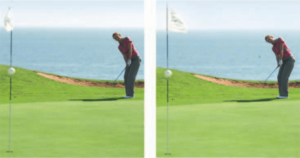
Step#1
Set yourself up 11yd (10m) from the flag. Make practice swings, but look at the target not the ground. Think about the force and length needed for the shot.
Step#2
Address the ball, take one look at the hole, and hit the chip. Do not hesitate, just re-create the same swing that you practiced in Step 1.
Rock the shaft
The relationship between your upper body and your arms is critical for any golf shot, even chip shots. These two core elements of your swing must work together to ensure reliable and consistent shots. This drill trains your body and arms to work together.
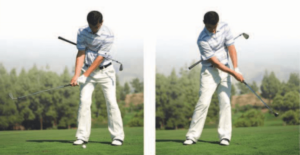
Step#1
Hold a club under your armpits so that the shaft is horizontal across your chest. Take a 9-iron and assume the normal address position, while keeping the horizontal shaft in place.
Step#2
Rock the shaft by turning your body back and through. Let your arms respond to this movement, and you will find the club track a neat path. Ensure that the shaft stays against your chest.
Add and subtract hours
Most golfers make too long a backswing and then decelerate into impact. This drill is based on the principle of determining your swing length using positions on an imaginary clockface. It will also help you learn to accelerate into the ball on every chip shot.
Step#1
Make a backswing with a pitching wedge where your hands swing to 7 o’clock. Then, accelerate through the hitting zone, and swing your hands to 4 o’clock, so that the follow-through is longer than your backswing. Note how far the ball travels.
Let your hands swing to 8 o’clock. Then, take an hour off the follow-through so that your hands are at 3 o’clock. Your follow-through will be longer than your backswing, making the ball travel farther.
Use a weak grip to keep the face open
Some of the world’s greatest chippers play short, delicate chip shots with a weak left-hand grip.
This technique helps keep the clubface open through the hitting zone, which promotes a higher- and softer landing ball flflight, enabling the most delicate of chips.
Using a weak left-hand grip is a technique that is well worth practicing—give this routine a try next time you are working on your chipping.
Step#1
Place about 12 balls on a good lie on the fairway. Play a standard chip shot with a pitching wedge, using your regular chipping technique. Observe the way the ball travels through the air and the amount of roll there is after landing.
Step#2
Now weaken your grip by rotating your left hand, so that you can barely see the second knuckle on the back of your left hand.
Step#3
Hit another chip shot. Since your weak grip effectively keeps the clubface more open through impact, this should translate into a slightly higher, floated trajectory with much less run on landing.
Alternate between hitting chip shots with your regular grip and others with a weak grip.
Try chipping using your putting technique
Any idea that might make the short game easier is well worth considering. The technique described in the following drill is employed by some of the world’s best players, which is reason enough to give it a try. It can be applied to a wide variety of clubs, from a pitching wedge down to an 8-iron, depending on the circumstances.
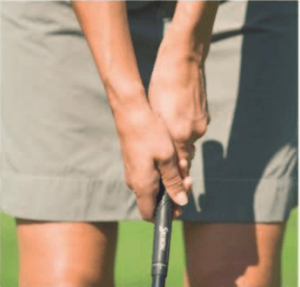
Step#1
Adopt your putting grip instead of your regular full-swing grip
“CHIPPING USING YOUR PUTTING TECHNIQUE HELPS IMPROVE YOUR CHIPS”
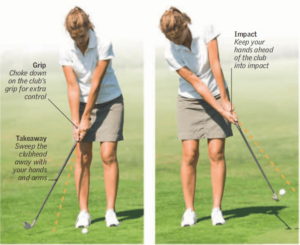
Step#2
Nudge your hands ahead of the clubhead and ball at address. The shaft of the club should now be leaning noticeably toward the target.
Step#3
Now simply replicate the swing action you would use for a long putt. As you swing your arms back and through impact, it is important that your hands remain ahead of the clubhead.



